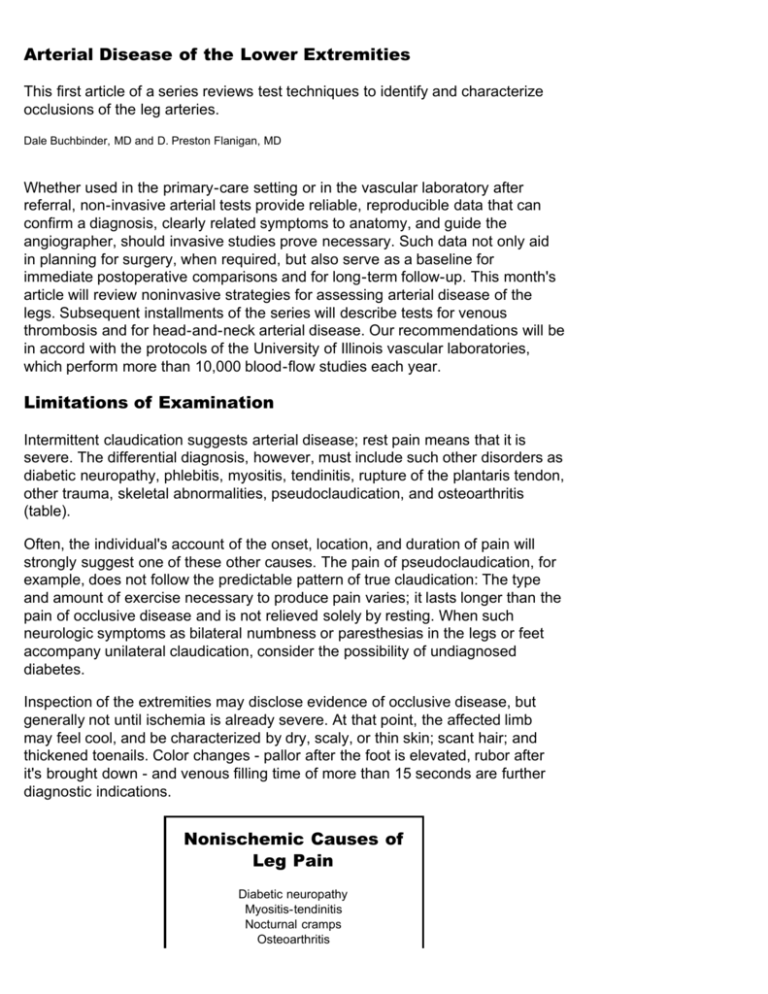Arterial Disease of the Lower Extremities
advertisement

Arterial Disease of the Lower Extremities This first article of a series reviews test techniques to identify and characterize occlusions of the leg arteries. Dale Buchbinder, MD and D. Preston Flanigan, MD Whether used in the primary-care setting or in the vascular laboratory after referral, non-invasive arterial tests provide reliable, reproducible data that can confirm a diagnosis, clearly related symptoms to anatomy, and guide the angiographer, should invasive studies prove necessary. Such data not only aid in planning for surgery, when required, but also serve as a baseline for immediate postoperative comparisons and for long-term follow-up. This month's article will review noninvasive strategies for assessing arterial disease of the legs. Subsequent installments of the series will describe tests for venous thrombosis and for head-and-neck arterial disease. Our recommendations will be in accord with the protocols of the University of Illinois vascular laboratories, which perform more than 10,000 blood-flow studies each year. Limitations of Examination Intermittent claudication suggests arterial disease; rest pain means that it is severe. The differential diagnosis, however, must include such other disorders as diabetic neuropathy, phlebitis, myositis, tendinitis, rupture of the plantaris tendon, other trauma, skeletal abnormalities, pseudoclaudication, and osteoarthritis (table). Often, the individual's account of the onset, location, and duration of pain will strongly suggest one of these other causes. The pain of pseudoclaudication, for example, does not follow the predictable pattern of true claudication: The type and amount of exercise necessary to produce pain varies; it lasts longer than the pain of occlusive disease and is not relieved solely by resting. When such neurologic symptoms as bilateral numbness or paresthesias in the legs or feet accompany unilateral claudication, consider the possibility of undiagnosed diabetes. Inspection of the extremities may disclose evidence of occlusive disease, but generally not until ischemia is already severe. At that point, the affected limb may feel cool, and be characterized by dry, scaly, or thin skin; scant hair; and thickened toenails. Color changes - pallor after the foot is elevated, rubor after it's brought down - and venous filling time of more than 15 seconds are further diagnostic indications. Nonischemic Causes of Leg Pain Diabetic neuropathy Myositis-tendinitis Nocturnal cramps Osteoarthritis Phlebitis Ruptured or strained plantaris tendon Skeletal abnormalities Trauma (old or new) Diminished or absent pulses may indicate occlusion. Palpate from the femoralis down to the dorsalis pedis artery. Auscultate for bruits over the lower abdomen and the femoral artery. When symptoms and examination findings are suggestive, non-invasive testing is indicated to provide more-definitive and quantitative evidence of a vascular problem. Researchers found little correlation between the results of palpating femoral pulses and the significance of occlusive disease 1 . Segmental Pressures The standard battery of tests for evaluating arterial flow in the legs begins with segmental Doppler pressures and calculation of an ankle/brachial index (ABI). Properly sized blood pressure (BP) cuffs are placed at the ankle, calf, lower thigh (above the knee), and upper thigh. Pressures at each location are taken with a Doppler ultrasound flow detector. The ABI is derived from the ratio of ankle to brachial pressures. In the supine position, the ratio is normally 1.0. Values between 0.71 and .096 suggest mild ischemia, 0.31 to 0.7 moderate ischemia, and 0.0 to 0.3 severe ischemia.2 Although ABI is generally a reliable indicator of arterial flow at rest, patients with hemodynamically subcritical arterial stenoses may have normal resting pressures. These individuals usually require additional testing - as described later in this article - to locate and evaluate such lesions. The value of segmental pressures is also limited in the elderly and in diabetics whose vessels are calcified and not normally compressible. The use of a directional Doppler ultrasound recorder is helpful for assessing blood flow in noncompressible vessels. The normal Doppler arterial wave is triphasic (figure 1): The first portion, with its steep peak, represents the high flow of systole. The second portion, dipping down, indicates the reverse flow in early diastole. The third segment of the wave, a small peak, represents the small forward flow of later diastole (aortic recoil). FIGURE 1. The normal triphasic Doppler arterial wave has an initial steep peak, representing the high flow of systole. The second portion, dipping down, indicates the reverse flow in early diastole. The third segment of the wave, a small peak, signifies the forward flow of late diastole. In contrast, the wave form recorded below a point of arterial stenosis or occlusion changes to a biphasic or monophasic pattern (figure 2). Uptake is slower, no reverse flow can be seen, and the second and third wave components are lost. Collateral circulation also produces this same pattern of flow. FIGURE 2. The wave form recorded below a point of arterial stenosis or occlusion changes to a biphasic or monophasic pattern. Uptake is slower, no reverse flow can be seen, and the second and third wave components are lost. Thus, normal resting pressures but abnormal Doppler waveforms in patients strongly suggest segmental large-vessel disease. A decreased popliteal wave in the presence of a normal femoral wave, for example, would indicate occlusion or stenosis of the superficial femoral artery. Progressive degeneration in wave forms and pressures seen segmentally down the leg would signal multisegmental disease (figures 3 and 4). Transmetatarsal and Toe Pressures Segmental pressures can also be used to evaluate circulation between the ankle and toes. Segmental pressures are obtained with a photoplethysmograph instead of Doppler ultrasound. A photosensitive transducer is placed on the toe and a small cuff is placed around the metatarsal area. The cuff is inflated until the wave form recorded by the plethysmographic transducer is obliterated. When the cuff is deflated, the systolic transmetatarsal pressure can be measured. Similarly, smaller cuffs can be wrapped around the toes, with transducers placed distal to the cuffs. This procedure can be used to obtain individual toe pressures (figures 5 and 6). Normally, toe pressures should be at least 60% of systemic pressure 3 . The absolute toe and transmetatarsal pressures correlate with the potential for healing after toe or forefoot amputations. Pressures as low as 20 mmHg in the toes and between 20 mm and 40 mmHg at the transmetatarsal region may be associated with adequate healing after amputations at their respective levels 4,5 .Ankle pressures may be normal, yet large gradients occur between the ankle, transmetatarsal, and toe pressures, should there be incomplete pedal arches or should small-vessel disease exist at the level of the foot or toes. Stress Testing The aforementioned tests provide information about lower-extremity circulation at rest but do not reflect the dynamic state and may, in fact, be misleading if patients have hemodynamically subcritical stenoses. Therefore, it is necessary to evaluate blood flow after stress or exercise. The treadmill test is the most commonly used technique. Segmental pressures and Doppler tracings are first recorded at rest. The patient then steps onto a treadmill adjusted to a rate of one-and-a-half miles per hour, and set at a 12º incline. After five minutes' walking, ankle pressures are retaken. Patients who cannot tolerate treadmill exercise can be tested, instead, with a pedal ergometer 6 . Inducing reactive hyperemia is an alternative test for those who are not able to exercise. A BP cuff, wrapped around the thigh, is inflated to above systolic pressure for three to five minutes. When the cuff is released, leg BPs are measured again. Because ischemia causes vasodilation, producing an effect similar to stressing the leg with exercise, this procedure can also demonstrate stenoses that are not hemodynamically significant at rest. KEYPOINTS When such neurologic symptoms as bilateral numbness or paresthesias in the legs or feet accompany unilateral claudication, suspect undiagnosed diabetes. Diminished or absent pulses indicate occlusion; to pursue the finding, palpate from the femoralis down to the dorsalis pedis artery. Papaverine Testing In patients with suspected aortoiliac disease despite normal resting blood flow, intra-arterial pressure monitoring and papaverine testing facilitate assessment of the aortoiliac system. These procedures are minimally invasive. Under sterile conditions, a small arterial cannula is placed in the common femoral artery and connected to a pressure transducer after an injection of 20 mg papaverine HCI, diluted to 10 mL in normal saline, pressures are recorded via the transducer. At the same time, a directional Doppler probe, positioned below the injection site, records Doppler velocity tracings. This technique detects arterial flow elevations, indicated by increases in velocity, and drops in the femoral/brachial index. A greater than 15% decrease in the femoral/brachial indices 7 or an increase in arterial flow of less than 100% indicates a hemodynamically significant stenosis proximal to the site of the papaverine injection. Papaverine testing is particularly helpful for evaluating the hemodynamics of the iliac system when a femorofemoral bypass may be required. Abnormal results indicate that the artery is not a suitable donor vessel. The procedure is also useful in preoperative planning for patients with multisegmental vascular disease. Demonstrating hemodynamic soundness of the iliac artery, for example, would indicate that only a distal procedure is needed. Disclosure of hemodynamically abnormal aortoiliac arteries might also call for an inflow procedure. Penile Perfusion Noninvasive evaluation of penile blood flow may be warranted to rule our vascular cause of impotence. A photoplethysmographic sensor is placed on the glans of the penis and a small BP cuff around the base can measure penile pressure, and a penile/brachial index (PBI) can be calculated 5 . An index of greater than 0.7 is considered evidence of adequate penile blood flow, ruling out vascular causes of impotence. A PBI of less than 0.7 indicates decreased blood flow, but the possible role of medications, diabetes, and other factors must be considered before impotence can be attributed to vascular problems. Clinical Applications In patients with exercise-induced leg pain, a finding of absent, diminished, or equivocal pulses is bound to raise the possibility of arterial insufficiency. When the pulses seem normal, however, noninvasive testing will distinguish arterial insufficiency from other causes of leg pain. Another valuable application of these procedures is documenting the severity of disease. This is particularly important when symptoms, such as rest pain, might signify either severe ischemia or significant neuropathy. The noninvasive laboratory will document whether there is a significant amount of ischemia present. Most patients with claudication usually have absolute ankle/brachial pressures between 70 mm and 100 mmHg, and ABI's of 0.5 to 0.8. Those with rest pain or gangrene usually will have absolute ankle pressures of less than 50 mmHg and ABIs of 0.3 or less 8 . Patients with diabetes mellitus, Buerger's disease, and chronic renal failure may have stiffer, calcified vessels, and their pressures may be falsely high for the extent of disease 2 . These tests are reasonably accurate, too, in pinpointing the specific site of disease. For example, superficial femoral artery occlusion is diagnosed in patients with normal upper-thigh pressures and Doppler tracings, decreased popliteal tracings, and decreased calf pressures. Suspect aortoiliac disease when femoral tracings are abnormal and upper-thigh pressures are decreased. The latter finding, however, may also be associated with high superficial femoral occlusions and profunda femoris disease. Normal popliteal results and decreased ankle tracings point to tibial vessel disease. In general, a pressure gradient of 30 mmHg or more between segments indicates arterial occlusive disease somewhere between the two pulse points. Segmental pressures are also valuable in planning therapy, as they can help predict the likelihood that foot lesions and amputations will heal. In one study, foot lesions healed in 92% of nondiabetic patients and in 76% of diabetic patients when ankle pressures were less than 55 mmHg, unless patients underwent arterial reconstruction. Virtually all foot ulcers healed in nondiabetics who had toe pressures of 30 mmHg or more; 94% of lesions healed in diabetics whose toe pressures exceeded 55 mmHg 9 . In general, spontaneous healing of foot ulcers is likely, and conservative therapy should be attempted if ankle pressure is more than 55 mmHg in nondiabetics and 80 mmHg in diabetics. In several studies, healing of below-knee amputations occurred in 88% to 100% of patients with calf pressures greater than 60 mmHg 10,11,12. Because diabetics' vessels may be calcified, yielding falsely high readings, it is extremely important to use these values cautiously in planning amputations: In one study, only 10% of below-knee amputations healed when calf pressures were less than 55 mmHg 13 . Finally, these non-invasive tests are powerful tools for long-term follow-up, to identify the causes of changes in symptoms, to track the progression of disease, and to identify patients who are candidates for arterial reconstructive surgery. At the University of Illinois, we retest such surgical patients at three-month intervals for the first two years after surgery, every six months for the next two years, and annually after that. In persons with functioning arterial grafts, slight changes in Doppler wave forms and decreases in segmental pressures represent early warnings of restenosis. These studies have led to timely diagnosis of impending failure of the graft in several patients. As a result, problems were easily corrected by minor surgical procedures so that vascular grafts, along with the patients' extremities, were salvaged. References 1. Sobinsky, KR, Borozan, PG, Gray, B, et al; Is femoral pulse palpation accurate in assessing the hemodynamic significance of aortoiliac occlusive disease? Am J Surg 148:214, 1984 2. Kempczinsky, RF; Clinical application of noninvasive testing in extremity arterial insufficiency. In: Kempczinsky, RF, and Yao, JST, eds:; Practical Noninvasive Vascular Diagnosis. Yearbook Medical, Chicago, 1982, pp 343-367. 3. Bridges, RA, and Barnes, RW; Segmental limb pressures. In: Kempczinsky, RF, and Yao JST, eds: Practical Noninvasive Vascular Diagnosis. Yearbook Medical, Chicago, 1982, pp 79-93. 4. Schwartz, JA, Schuler, JJ, O'Connor, RJA, et al; Predictive value of distal perfusion pressure in the healing of amputation of digits and the forefoot. Surgery 154:865, 1982. 5. LaRosa, MP, Buchbinder, D, Gray B, et al; Penile arterial study by photoplethysmography. Bruit 8:225, 1984. 6. Sobinsky, KR, Williams, LR, Gray, B, et al; Supine exercise testing in the selection of suprainguinal versus infrainguinal bypass in patients with multisegmental arterial occlusive disease (presented at the 1984 meeting of the Association of Veterans administration surgeons). 7. Williams, LR, Gray, B, Ryan, TJ, et al; Preoperative hemodynamic assessment of multisegmental lower extremity arterial disease using papaverine hydrocloride. Bruit 8:19, 1984. 8. Yao, JST; New techniques in objective arterial evaluation. Arch Surg 106:600, 1973. 9. Carter, SA; The relationship of distal systolic pressures to healing of skin lesions in limbs with arterial occlusive disease, with special reference to diabetes mellitus. Scand J Clin Lab Invest 31 (suppl.128):239, 1973. 10. Raines, JK, Darling, RC, Buth, J, et al; Vascular laboratory criteria for the management of peripheral vascular disease of the lower extremities. Surgery 79:21, 1976. 11. Dean, RH, Yao, JST, Thompson, RC, et al; Predictive value of ultrasonically derived arterial pressures in determination of amputation level. Am J Surg 41:731, 1975 12. Barnes, RW, Shanik, GD, and Slaymaker, EE; An index of healing in below-knee amputation. Surgery 79:13, 1976. 13. Gibbons, GW, Wheelock, FC, Jr, Siembieda, C, et al; Noninvasive prediction of amputation level in diabetic patients. Arch Surg 114:1253, 1979.





![[09]. Strategies for Growth and Managing the Implications of Growth](http://s2.studylib.net/store/data/005486524_1-1f063ac78a31ad020721eab31440cecf-300x300.png)
